Hair loss, in most cases, is a serious concern that negatively affects the patient’s mental health and self-image, and by the age of 50, 50% of men experience balding.
So, it is no wonder that the hair restoration industry reached a net worth of 4.5 $ billion by 2021, according to the ISHRS report, with thousands of clinics across the world using different hair transplant technologies.
Every day, you can see thousands of patients with amazing and natural results on the streets or on social media. However, there is also a considerable number of patients who didn’t get the desired results.
Ultimately, understanding where the industry is going or what your chances of success are can be overwhelming due to the high number of resources to choose from.
That’s why I’ve decided to bring together all the information and statistics you need about hair restoration here in this summarized article:
Table of Contents
All the data here are fresh and are according to the updates and reports by the International Society of Hair Restoration Surgery (ISHRS), including the latest developments and technologies in hair transplants.
Further updated with the developments and additions by 2024.
Let’s start by looking at the popularity of the field:
The Popularity of Hair Transplants
1- In 2021, approximately 703,183 patients underwent hair transplant surgeries, according to ISHRS data.
The actual number of patients who underwent hair transplant surgeries is possibly much higher than this number since these were all the cases reported by the members of the organization.
To calculate the actual number, you need the numbers from non-ISHRS member clinics and also black-market clinics, which are on the rise.
Regardless, this high number alone is enough to show the magnitude of attention hair transplants get.
2- The number of patients who had hair restoration surgeries was 735,312 in 2019, so the total number saw a 4% decrease.
Does this mean fewer people got hair transplants?
It might.
OR it might suggest that black-market hair transplant clinics and other clinics that aren’t registered with regulating organizations are rising and getting more share than in 2019.
My personal opinion, based on my experience in Istanbul (one of the busiest hair transplant destinations in the world), is that it is the latter possibility.
⚠️ Also, as ISHRS reports, the emergence of the 2019 pandemic could have a slight effect on this minor decrease.
3- 87.3% of all hair transplant surgeries in 2021 were done on male patients, while only 12.7% were done on female patients.
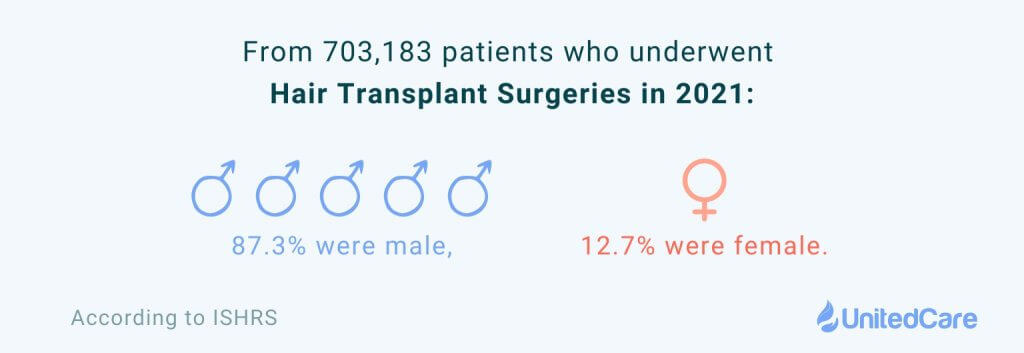
There are two critical variables for this statistic.
1️⃣ The first is that male pattern baldness affects the overall appearance of hair much more than female pattern baldness due to the differences in hair loss patterns.
2️⃣ Secondly, since the frontal hairline is not affected by female pattern baldness, hair transplantation, which is advantageous for restoring the hairline, becomes a last resort option.
4- An average member of ISHRS performed 14 hair transplant surgeries per month.
I joined ISHRS in 2022, and I believe every hair transplant surgeon should join since being in a regulating organization means you have much more accountability to your patients and peers, and accountability brings better results with it.
If you’re thinking of getting a hair transplant, make sure your surgeon is an ISHRS member.
5- The crushing majority of hair transplant patients were aged 30-49 (57.2% of men and 54.8% of women).
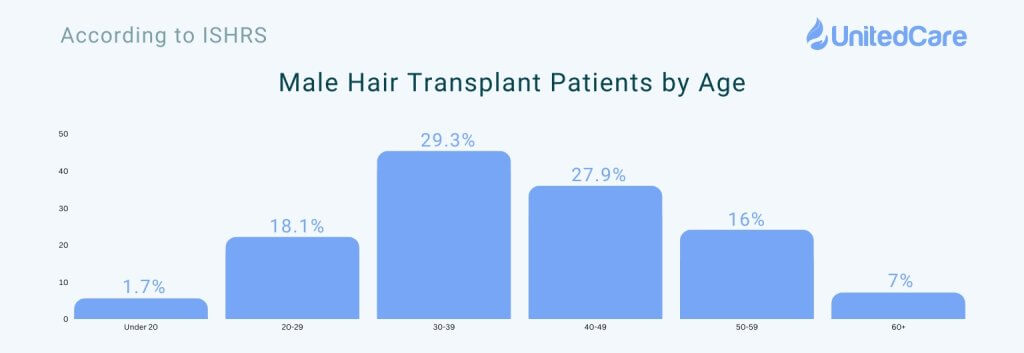
Androgenetic alopecia usually affects your scalp when you become a young adult. But it takes time to produce visible hair loss since you need to lose a tremendous amount of hair before you can visibly see your hair thinning.
Between the ages of 25 and 30, most of my patients noticed their hair loss and started looking for a way to treat it. And for most patients, the issue’s significance is observed after the age of 30.
That’s why most patients are aged 30-49.
👉 Remember: The earlier you start an effective treatment (medications or surgical), the better results you’re going to get unless you have aggressive alopecia, which might make it hard to predict how your hair loss is going to proceed.
So, your safest bet is to always get a consultation as early as possible:
UnitedCare provides advanced FUE surgeries with bio-enhancements.
Restore your natural look with a Dermatosurgeon now before it is too late:
6- 81% of all hair restoration patients underwent surgery to treat genetic hair loss/pattern baldness.
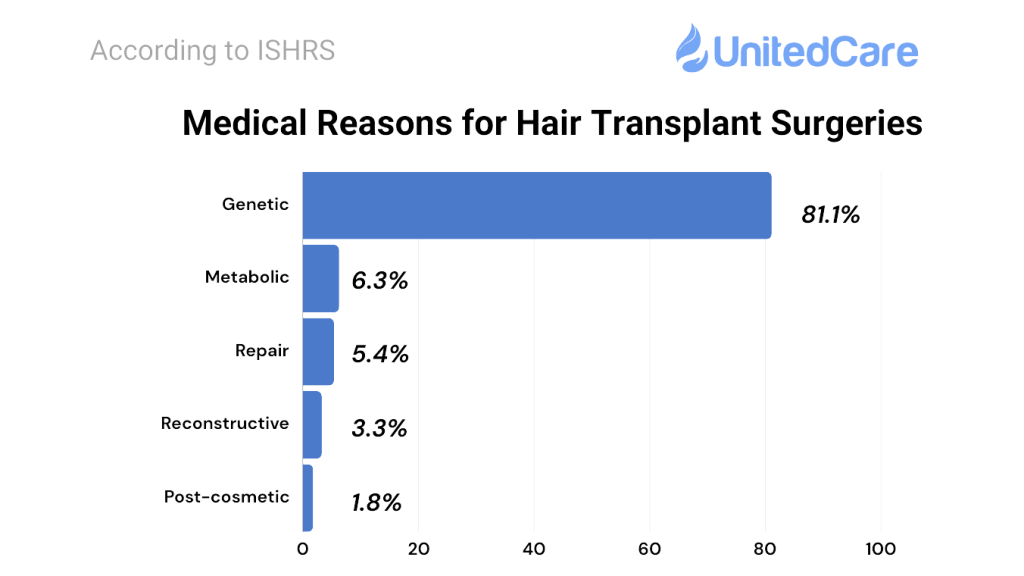
Pattern baldness is responsible for more than 95% of hair loss in men, so this statistic is not really a surprise.
Here’s a more detailed list of the medical reasons for hair transplant surgeries:
➡️ Genetic hair loss – 81.1%
➡️ Dermatologic, metabolic/hormonal, nutritional, or medication-induced hair loss – 6.3%
➡️ Repair of previous surgery from another physician / black market hair transplant – 5.4%
➡️ Reconstructive needs – 3.3%
➡️ Post-cosmetic surgery needs – 1.8%
7- Most patients underwent a hair transplant surgery to treat their loss of hair, improve their social/dating lives (37% of patients), or have a better professional life/career (34.7% of patients.)
A receding hairline’s appearance may play a lesser role in your social and professional life than the psychological issues that might occur due to it.
According to research, those with hair loss may be at higher risk for developing a severe depressive episode, anxiety disorder, social phobia, or paranoid disorders. Numerous studies are showing higher stress and anxiety levels in people with hair loss.
So, it makes sense to assume that after a successful hair transplant and your natural hairline restored, you will have fewer obstacles standing between you and success in your professional and social life.
Methods and Procedures
8- Of all the hair transplant surgeries done in 2021, 75.4% were done using Follicular Unit Extraction (FUE), while 21.3% were done with Follicular Unit Transplantation (FUT).
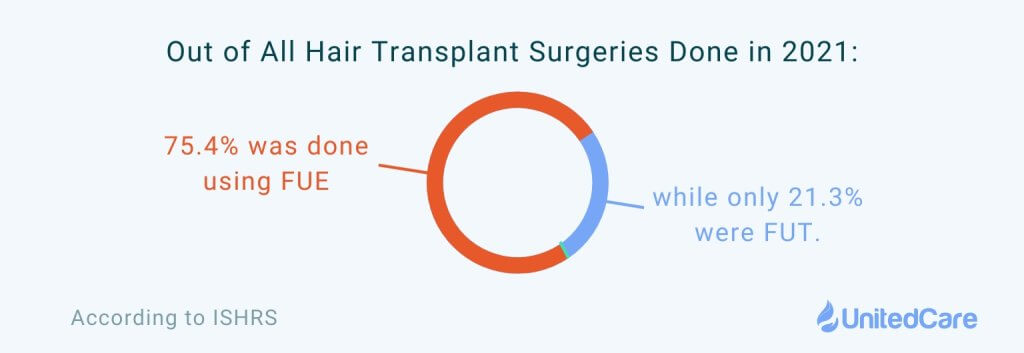
Follicular Unit Transplant (FUT) is where the donor’s hairs are harvested from a strip of tissue cut from the donor area. Naturally, this “cutting” can leave a scar area that can be visible if you wear your hair short.
That is why patients are leaning more towards Follicular Unit Extraction (FUE), where the individual hair follicles are harvested directly from the scalp with a unique pen tool, often leaving very few scars that quickly heal.
FUT patients can often undergo FUE surgery for a second time just to cover the scar on the donor area to get their natural look back. This is another reason patients undergo multiple surgeries to get their desired look.
9- 71.4% of all FUE surgeries consisted of motorized FUE techniques that didn’t use suction.
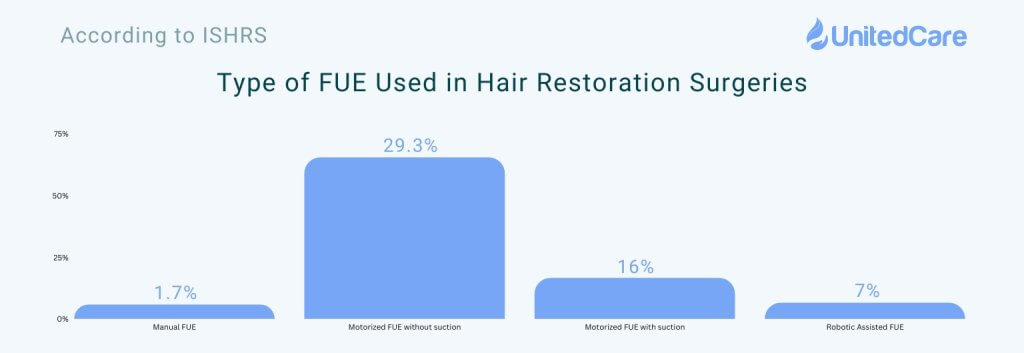
Alternatively, 16.5% were motorized FUE with suction, 5.7% were FUE surgeries that were completely manual, and 6.4% were robotic-assisted FUE.
10- Robotic-assisted FUE’s improved share passed beyond 20% in the last 3 years.
More and more clinics adopted robotic-assisted hair transplant surgeries in 2021, like the ARTAS Robot or Ke-Bot, which we use at UnitedCare.
These new technologies allow us to see target results in 3D and even operate during the extraction phase of the surgeries.
11- 54.6% of surgeons used .81mm-.9mm FUE punch during hair transplant surgeries, while 37% used .91mm-1mm.
The smaller the punch you use, the less damage you do to the donor and recipient area, so the less time it’ll take to heal.
However, there’s a limit to how small we can go in terms of punches since if you can’t operate with precision, you will damage the extracted hair follicle.
To achieve that perfect balance, most surgeons prefer .81mm to 1mm.
12- The most prescribed supportive treatments for hair transplants were 1 mg Finasteride (69.1% of the time), followed by 2% or 5% Minoxidil (53.0%) and 5% Minoxidil foam (53.0%).
To support the success of hair transplants, each doctor prescribes some amount of supplements to their patients.
Sometimes, these can be alternatives to hair transplants altogether (depending on the patient’s hair loss level). However, ideally, a mix with proper hair transplant surgeries is the most promising solution.
13- Of all the donor hair used in hair transplantations, 93.2% was harvested from the scalp.
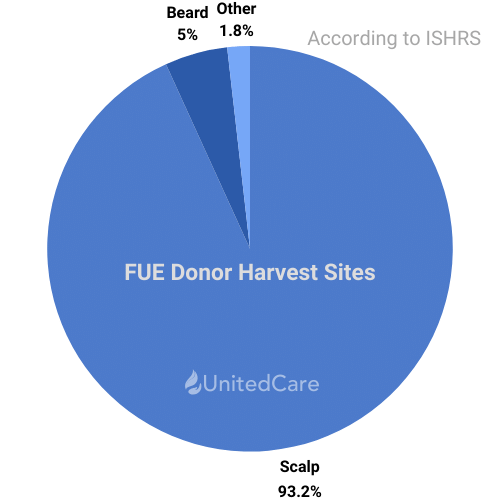
In a hair transplant surgery, the donor’s hair is usually harvested from the back of your scalp.
This is because the back and the sides of your scalp are mostly unaffected by hormones that cause androgenetic alopecia, which makes them grow forever (as long as they are safe from other sources of hair loss), even when it is implanted into the bald areas.
Even for facial hair transplants or eyebrow transplants, surgeons will prefer to harvest hair from the scalp.
But, in rare cases, beard and chest hair can also be used as donor areas.
14- The average graft per first hair transplant procedure in 2021 was 2,176.
When you look up costs of hair transplant surgeries, clinics usually provide “2000 Graft Cost” along with the “price per graft cost.”
This is mainly because 2000 grafts are ideal for most patients who undergo hair restoration surgeries. In fact, 58.1% of all hair transplant surgeries used between 2000 and 2999 grafts during the surgery.
The percentage of smaller surgeries that required less than 2000 grafts was 26.7%, while 12.7% used 3000 to 3999 grafts.
15- The average cost of a hair transplant in Turkey in 2024 is $2570 for 2500 grafts.
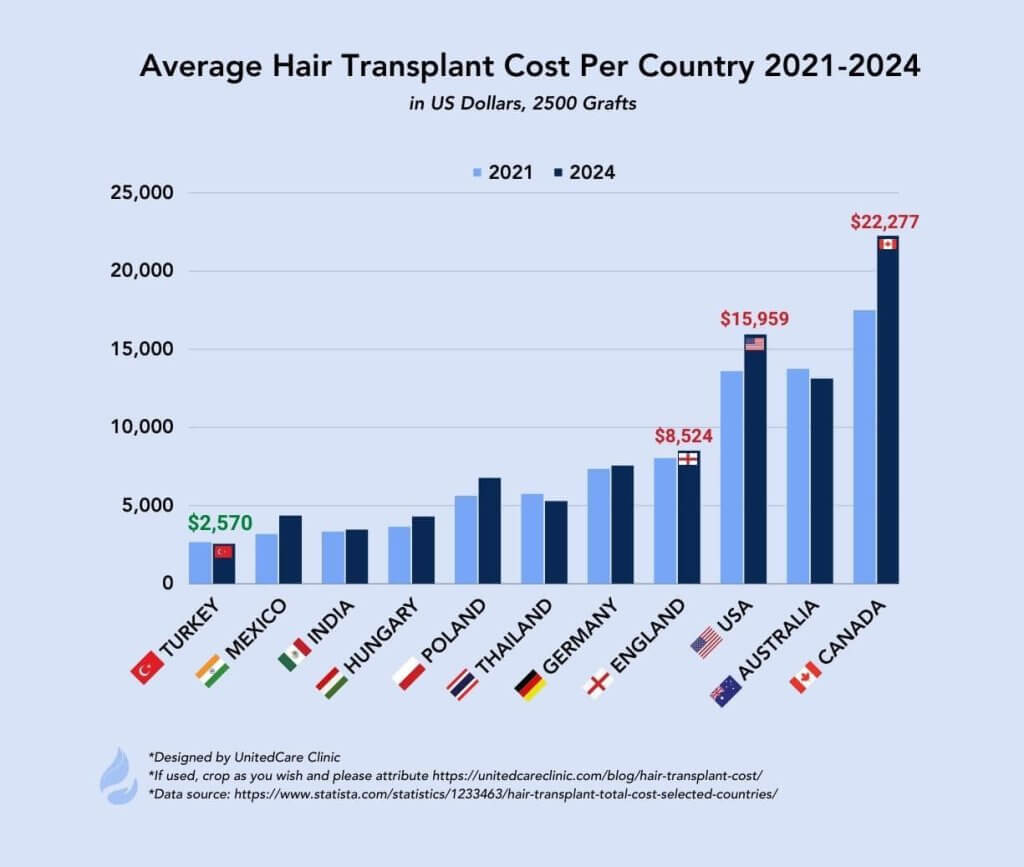
Currently, a 2500-graft hair transplant in Turkey costs 2570$ on average, which is the lowest price worldwide.
▶️ Hair transplant prices are cheaper in Turkey mainly because of the currency difference.
Since the Turkish Lira has less value than the Euro and USD, the cost of running a hair transplantation clinic in Turkey is way cheaper than it is for any other top location.
▶️ Also, the competition in Turkey has developed the hair transplant industry in-depth.
In fact, many hair transplant surgeons and famous clinics in Turkey have been awarded international awards because of this.
16- 85% of all hair restoration surgeries were done on the scalp, while facial hair transplants followed with 5%.

As I’ve mentioned, pattern baldness is the number one reason for hair loss and transplants. So, it makes sense for the crushing majority of hair transplants to be done on the scalp hair.
Black-Market Hair Transplants – Unfortunately, Real ⚠️
Black-market never means something good, and the case continues for this instance.
In the last few years, more and more clinics without permits or any real doctors present have been operating worldwide.
Offering lower prices than the average clinic in their city/country, these clinics built some appeal, exploiting patients’ frustrations and the mental challenges they go through because of hair loss.
ISHRS and all its members stand against these clinics that endanger patients’ lives and assure you that the promises these clinics give are unreal and are NOT worth risking your life.
Make sure you have your hair transplant done by an ISHRS member or through the suggestion of a real dermatologist doctor.
17- 5.4% of all hair transplant surgeries were done to repair damage caused by black-market hair transplant surgeries.
Unfortunately, hair transplant failures caused by black-market clinics are getting increasingly common.
And last year’s statistics showed an increase in the number of patients who had a black-market hair transplant surgery and needed to recover from it.
18- 51% of ISHRS members reported there were black market clinics in their cities
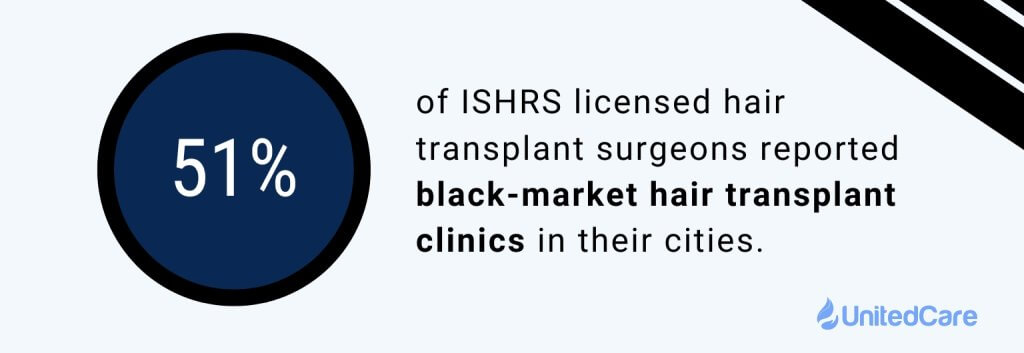
ISHRS has over 1200 members within 70 countries, which suggests that more than 600 hair transplant surgeons have encountered black-market hair transplant clinics.
This shows how common and visible these illegal and unsafe operations are.
19- 16% of ISHRS members changed their pricing because of the black-market hair transplant clinics.
It’s an upsetting fact that some clinics had to acknowledge black-market clinics as competition and adjust their pricing to keep their clinics running.
However, I agree that a lot of clinics can and should reduce their overall costs to make technologies more available and accessible while applying modern techniques for surgeries, which I am sure would help keep patients away from black-market clinics.
Results
20- 68.2% of patients achieved the desired results with their first surgery, while the average patient had 1.4 until they saw their desired results.
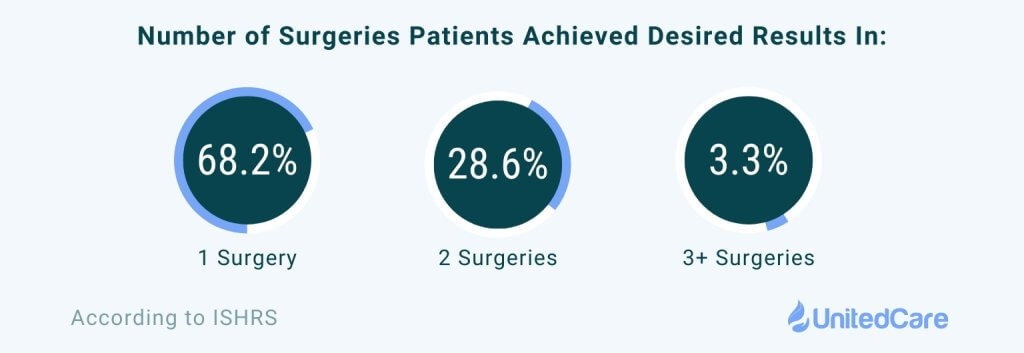
In rare cases (at least that I encountered), there would be a need for second or more hair transplant surgeries to get to the patient’s desired results.
But that’s not the case for the majority of people.
Since newer technologies are being used to ensure graft survival, like DHI and bio enhancements, the first surgery is enough to help patients get to their desired look
21- Between 2019 and 2021, the percentage of patients satisfied with the results of their first surgery improved by 19%, while the average number of surgeries to achieve desired results decreased by 59%.
The average number of surgeries for patients to get their desired results was 3.4 in 2019.
It was an intimidating statistic that made patients question the success rate of these surgeries.
So, it is a huge development to see that number drop to 1.4 in 2021 and decrease by 59%.
This improvement suggests that hair transplant surgeries are becoming more successful, possibly due to people having more access to information and clinics applying state-of-the-art technologies and methods to ensure success.
22- The most common complaint (28.1%) of hair transplant patients following the surgery was having less dense hair than they had expected.
A hair transplant does not increase the number of hair follicles on your scalp.
We extract donor hair from the donor area and implant it into the bald areas to restore your hairline and natural-looking hair.
But, with the correct aftercare and a change of some habits, you can promote hair growth on your scalp and even increase the thickness of your hair, giving it a dense look.
23- Studies suggest that a hair transplant on scar tissue can promote scar rejuvenation and even make the scar tissue display behaviors of healthy skin.
A recent study revealed that hair transplants on scar tissue are suitable for covering up the scar and can be highly effective in promoting healing over time.
The research on three patients who had scar-related hair transplants showed that scar tissue improved in healing and promoted growth following the implantation of hair follicles.
This is a positive development not only for the field of hair restoration but for dermatology, too, since the effects can be used to heal scars faster and help patients get to their desired looks.
Bonus statistic: UnitedCare had a 100% patient satisfaction rate in 2023
Last year, we had dozens of patients from around the world who underwent hair transplant surgeries at UnitedCare.
As a dermatologist surgeon, I personally attended each patient’s surgery, which is something that doesn’t apply to most clinics (especially the black market).
It is a joyful experience for all of us at UnitedCare to help patients become a better version of themselves by achieving the look that they want.
Here’s Matt’s, a Canadian arm wrestler, experience with us:
This can be your experience, too 👇🏻
Restore your hairline with an expert dermatologist.
Ensure the success and safety of your hair transplant with advanced FUE surgeries and bio enhancements:
Frequently Asked Questions (FAQs)
What is the success rate of hair transplants?
The percentage of people who succeed with their first hair transplant is over 68%, and if you count it as the first 2 hair transplant surgeries, the success rate of hair transplants goes up to 97%.
How many people get a hair transplant each year?
In 2021, 703,183 people had hair transplant surgeries, while in 2019, the number was 735,312.
Why do people get hair transplant surgeries?
Most patients get a scalp hair transplant (81%) to improve their social and dating lives (37%) or professional life/career (34.7%.)

